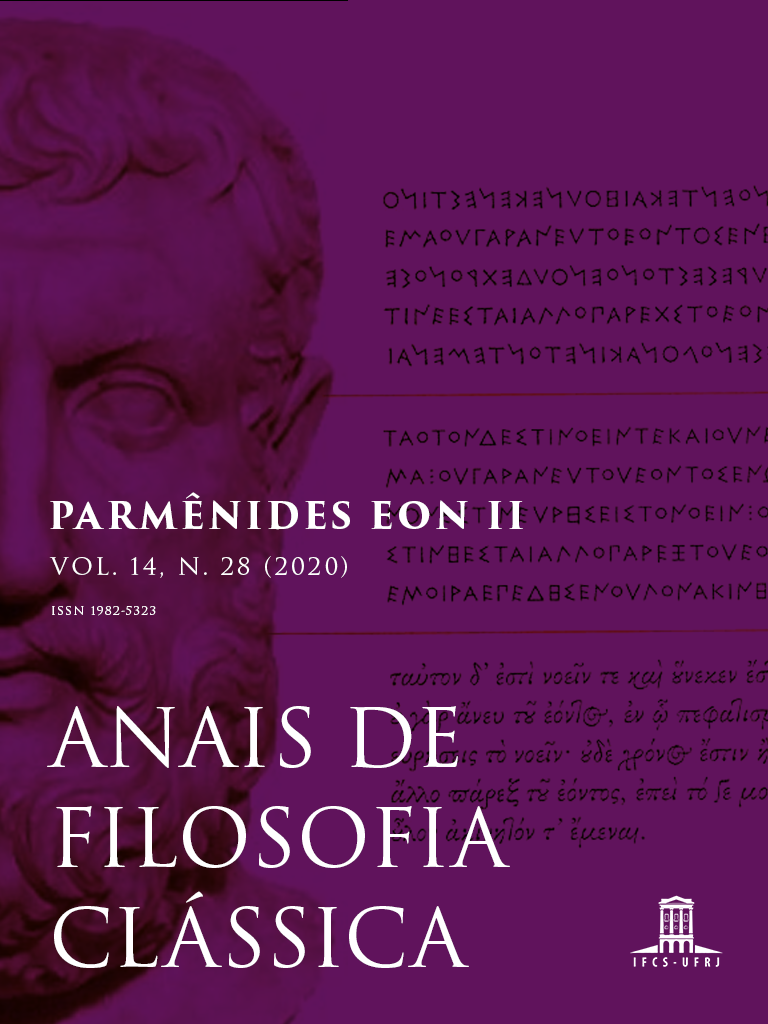Parmenides on Knowing What-is and What-is-not
DOI :
https://doi.org/10.47661/afcl.v14i28.38781Mots-clés :
descriptive metaphysics, revisionary metaphysics, knowing, learning, thinking, testing, discovery, signs, what-is, what-is-not, elenchos, sêma, oida, gignôskô, manthano, punthanomai, noeô, Aristotle, Homer, ParmenidesRésumé
Parmenides presented himself to his audiences as one who had achieved a profound insight into the nature of to eon or “what-is.” In support of this claim he conducted an elenchos or “testing” of the ways of inquiry available for thinking, in the process revealing a set of informative sêmata or “signs.” In this respect Parmenides was speaking the language of discovery heard elsewhere in early Greek poetry. Similarly, his claim that we can neither learn nor know about what-is-not (hence must not say or think “it is not”) was justified by the ordinary meaning of the ancient Greek verbs for learning and knowing. Strikingly, Parmenides’ revisionary metaphysics rested in large measure on a widely shared view of what can be learned, known, and made known to others.
Références
Works Cited
Bicknell, P. J., “Parmenides, Fragment 10,” Hermes 96 (1968) 629-631.
Burkert, W., “Das Proömium des Parmenides und die Katabasis des Pythagoras,” Phronesis 14 (1969) 1-30.
Coxon, A. H., The Fragments of Parmenides (Las Vegas, Zurich, and Athens: Parmenides Publishing, 2009).
Curd, P., The Legacy of Parmenides (Princeton: Princeton University Press, 1998; reprinted Las Vegas, Zurich, and Athens: Parmenides Publishing, 2004).
Darcus, S., “-phrôn Epithets of thumos,” Glotta 55 (1977) 178-82.
Diels, H. and W. Kranz, Die Fragmente der Vorsokratiker. 6th edition, 3 volumes. (Berlin: Weidmann, 1951-52).
Gallop. D., Parmenides of Elea (Toronto: University of Toronto Press, 1984).
Johansen. T., “Parmenides’ Likely Story,” Oxford Studies in Ancient Philosophy 50 (2016) 1-29.
Kahn, C., “The Thesis of Parmenides,” The Review of Metaphysics 22 (1969) 700-724.
Kirk, G., J. Raven, and M. Schofield, The Presocratic Philosophers. 2nd edition (Cambridge: Cambridge University Press, 1983).
Lesher, J., “Parmenides’ Critique of Thinking: The poludêris elenchos of Fr. 7,” Oxford Studies in Ancient Philosophy 2 (1984) 1-30.
Lesher, J., “The Significance of kata pant’ atê in Parmenides Fr. 1.3,” Ancient Philosophy 14 (1994) 1-20.
Liddell, H. and R. Scott, A Greek-English Lexicon, rev. H. Jones and R. McKenzie, with the 1968 Supplement, 9th edition (Oxford: Oxford University Press, 1976). [Cited as LSJ]
Lyons, J., Structural Semantics (Oxford: Blackwell Publishing, 1963).
McKirahan, R., “Signs and Arguments in Parmenides B 8” in P. Curd and D. Graham (eds.), The Oxford Handbook of Presocratic Philosophy (Oxford: Oxford University Press, 2008), 189-229.
Mourelatos, A. P. D., The Route of Parmenides. Revised and expanded edition (Las Vegas, Zurich, and Athens: Parmenides Publishing, 2008).
Renehan. R., Review of Coxon 1986 in Ancient Philosophy 12 (1992) 395-409.
Rijksbaron, A., The Syntax and Semantics of the Verb in Classical Greek (Amsterdam: J. C. Gieben, 2002).
Strawson, P., Individuals: An Essay in Descriptive Metaphysics (London: Methuen and Co. Ltd., 1959).
Sullivan, S., “Kradiē, Ētor, and Kēr in Poetry after Homer,” Revue belge de Philologie et d’histoire 73 (1995) 17-38.


